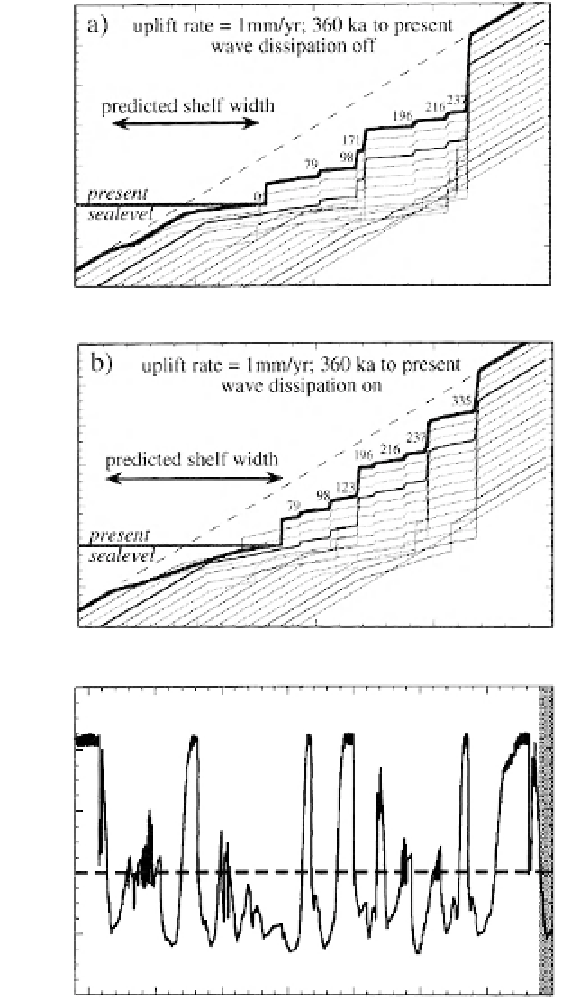Geology Reference
In-Depth Information
500
A
Modeling Marine Terraces
without wave dissipation
400
300
216
237
196
200
p
redicted shelf width
171
98
100
79
present
sea level
0
0
steady
rock
uplift
-100
-200
0
5
10
15
20
Distance (km)
500
B
400
335
with wave dissipation
Fig. 11.10
Evolution of marine terraced
profile.
A, B. Modeled evolution of marine terraced profile
on an uplifting coastline, and C, the modeled cliff
recession-rate history. Sea cliff retreat is shown for
350 kyr models, given uniform and steady 1 mm/yr
of uplift of the rock mass, and sea-level history
derived from the marine oxygen isotope curve
(Fig. 2.3). Eroded rock is shown in gray. Models
differ only in that in A wave energy is assumed
not to be dissipated by offshore bathymetry, such
that cliff retreat rates are steady (dashed line in C),
whereas in B wave dissipation is allowed, being
strongest on wide nearshore platforms. This
dissipation results in the variations in the cliff
retreat rates shown in the solid line in C. The final
profiles differ in the width of the final offshore
platforms, being narrower in the case allowing
wave dissipation, and in the total amount of
erosion, being greater without wave dissipation.
In addition, the final sequence of recorded marine
terraces differs. With wave dissipation allowed,
more terraces are recorded, e.g., the 123 ka notch.
Such small terraces are erased in the case of more
efficient cliff retreat when dissipation is ignored.
Modified after Anderson
et al.
(1999).
300
237
216
196
200
p
redicted shelf width
123
98
100
eroded volume
79
present
sea level
0
steady
rock
uplift
-100
-200
0
5
10
15
20
Distance (km)
1.0
C
narrow shelf: low dissipation
0.8
0.6
0.4
0.2
wide shelf: high dissipation
0.0
350
300
250
200
150
100
50
0
Time (ka)
years (in some cases), why do we not see many
tens of terraces, even accounting for the terrace
survival problem? This problem has been
approached as well in simulations both of the
channels that cut through the terrace sequence
and of the decay of the sea cliffs once abandoned
by relative sea-level drop (Anderson
et al
., 1999).
Whereas cliff decay is a slow, essentially diffusive,
process, it appears that the fluvial incision of the
terraced landscape, as well as the hillslope
processes that are slaved to these channels
(Fig. 11.11B), are more efficient at cutting away
terraces. This degradation can be seen easily in a
DEM of the Santa Cruz terraces (Fig. 11.11A) as
the terrace edges become less distinct and their
flats less extensive. As the rivers ramify inland,






























































